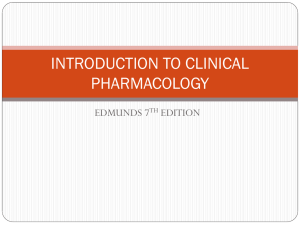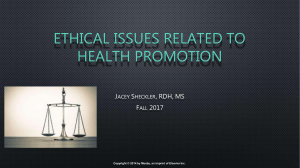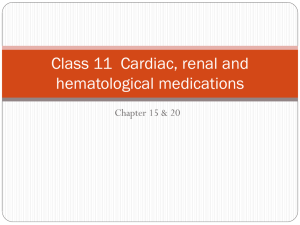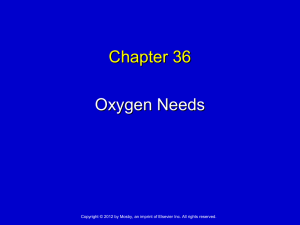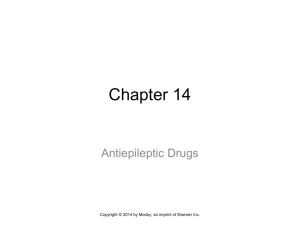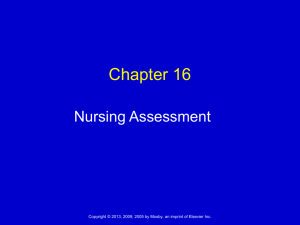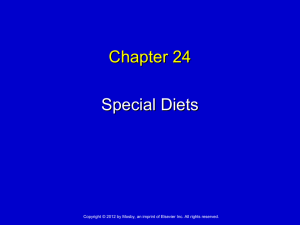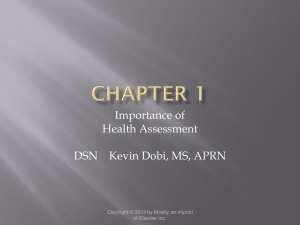GI MEDS
advertisement
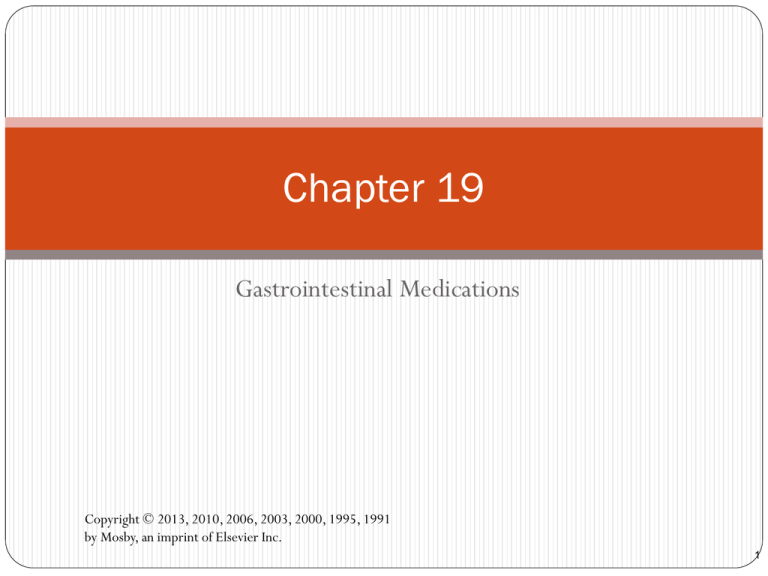
Chapter 19 Gastrointestinal Medications Copyright © 2013, 2010, 2006, 2003, 2000, 1995, 1991 by Mosby, an imprint of Elsevier Inc. 1 Learning Objectives Identify common uses for antacids and histamine H2-receptor antagonists Compare and contrast the actions of anticholinergic and antispasmodic medications on the gastrointestinal (GI) tract Compare the actions and adverse reactions of the five major classifications of laxatives 2 Copyright © 2013, 2010, 2006, 2003, 2000, 1995, 1991 by Mosby, an imprint of Elsevier Inc. Antacids, H2-Receptor Antagonists, Proton Pump Inhibitors Action and Uses Antacids neutralize hydrochloric acid which decreases gastric pH; inhibit pepsin Histamine H2-receptor antagonists displace histamine from the receptor site and prevent stimulation of the secretory cells (neutralize acid and promote healing of ulcers) Proton pump inhibitors irreversibly stop the acid secretory pump embedded in the parietal cells for the length of time they are taken 3 Copyright © 2013, 2010, 2006, 2003, 2000, 1995, 1991 by Mosby, an imprint of Elsevier Inc. Antacids, H2-Receptor Antagonists, Proton Pump Inhibitors (cont.) Nursing Implications and Patient Teaching Assessment: interaction possibilities Diagnosis: smoking/alcohol intake, stress Planning: increase fluid intake Implementation: forms and routes of administration vary Evaluation: continued symptoms of GI distress Patient and Family Teaching: administration times and drug specificity, adverse reactions, drug storage and efficacy, medical follow-up, drug interactions 4 Copyright © 2013, 2010, 2006, 2003, 2000, 1995, 1991 by Mosby, an imprint of Elsevier Inc. Antacids Tums calcium carbonate Riospan magaldrate Milk of Magnesia magnesium hydroxide Mag Ox magnesium oxide Antacid combinations Maalox magnesium hydroxide & aluminum hydroxide Gelusil aluminum hydroxide, magnesium hydroxide & simethicone Generics: aluminum carbonate sodium bicarbonate **Aluminum tends to constipate a person. H2 Receptor antagonists (-tidines) Tagamet cimetidine Pepcid famotidine Axid nizatidine Zantac ranitidine Gastric medications Treatment for H pylori Miscellaneous Helidac/ Pylera Cytotec Bismuth subsalicylate, misprostol metronidazole & tetracycline Get 4 pills with each dose QID Chew the bismuth and swallow the Metro. & tetra. acts to increase gastric mucus layer/ protects Carafate sucralfate coats stomach wall/ protects ulcers so they can heal Proton Pump Inhibitors (PPIs) -prazoles Nexium esomeprazole Prevacid lansoprazole Prilosec omeprazole Protonix pantoprazole Aciphex rabeprazole Anticholinergics and Antispasmodics Action and Uses Anticholinergic-antispasmodic preparations reduce GI tract spasm and intestinal motility, acid production, and gastric motility, thus reducing pain Use: peptic ulcer, pylorospasm, biliary colic, hypermotility, irritable colon, and acute pancreatitis Antidiarrheals reduce the fluid content of the stool and decrease peristalsis and motility of the intestinal tract; increase smooth-muscle tone and diminish secretions Use: treatment of nonspecific diarrhea or diarrhea caused by antibiotics 9 Copyright © 2013, 2010, 2006, 2003, 2000, 1995, 1991 by Mosby, an imprint of Elsevier Inc. Anticholinergics Belladonna Alkaloids Anticholinergics Sal-Tropine Librax atropine sulfate Scopace scopolamine clidinium Robinul glycopyrrolate Pro-Banthine Anticholinergic combo drug Donnatol hyoscyamine, atropine, scopolamine & phenobarbital propantheline Gastrointestinal medications antispasmodic GI Stimulant Bentyl Reglan dicyclomine metaclopramide Increase speed at which the stomach empties Antidiarrheals Pepto-Bismol Bismuth subsalicylate (think ASA) Lomotil – ‘Lo motility’ diphenoxylate and atropine sulfate Kaopectate kaolin & pectin Bacid / Lactinex lactobacillus Immodium loperamide Asacol – for ulcerative colitis mesalamine Azulfidine – for ulcerative colitis sulfasalazine Question 1 Antidiarrheals act by: 1. 2. 3. 4. 13 increasing the fluid content of the stool. decreasing peristalsis in the intestinal tract. increasing digestive secretions. decreasing smooth muscle tone. Copyright © 2013, 2010, 2006, 2003, 2000, 1995, 1991 by Mosby, an imprint of Elsevier Inc. Laxatives Action and Uses Bulk-forming laxatives absorb water and expand, increasing the bulk and moisture content of the stool; peristalsis increases, and absorbed water softens the stool Fecal softeners lower the surface tension, which allows the fecal mass to be softened by intestinal fluids Hyperosmolar laxatives produce an osmotic effect by drawing water into the bowel, thereby promoting peristalsis and bowel movement 14 Copyright © 2013, 2010, 2006, 2003, 2000, 1995, 1991 by Mosby, an imprint of Elsevier Inc. Laxatives (cont.) Action and Uses (cont.) Lubricant laxatives create a barrier between feces and the colon, preventing colon reabsorption and causing softening of the stool Stimulant or irritant laxatives work according to the agent 15 Copyright © 2013, 2010, 2006, 2003, 2000, 1995, 1991 by Mosby, an imprint of Elsevier Inc. Laxatives Bulk forming Fecal softener Citrucel Colace methylcellulose Metamucil / Fiberall psyllium seed docusate Laxatives cont. Saline / hyperosmolar Lubricants Philips Milk of Magnesia Emulsoil magnesium Fleet’s enema sodium salts castor oil Stimulant / Irritant Dulcolax / Correctol bisacodyl Cascara cascara sagrada Senekot / Ex-Lax senna Antiflatulents Break up and prevent mucus-surrounded pockets of gas from forming in the intestine; reduce gastric pain Intended for short-term use 18 Copyright © 2013, 2010, 2006, 2003, 2000, 1995, 1991 by Mosby, an imprint of Elsevier Inc. Miscellaneous GI Medications Antiflatulents activated charcoal (think liquid briquettes from the grill) Mylanta Gas Relief / Mylicon Simethicone – makes the bubbles smaller so they are easier to pass Emetics Syrup of Ipecac – ipecac (will clean out entire GI tract!!) Gallstone-Solubilizing Agents Act on the liver to suppress cholesterol and cholic acid synthesis; biliary cholesterol desaturation is enhanced, and breakup occurs Used in selected patients with radiolucent stones in gallbladder Adverse reactions: dose related; diarrhea, anorexia, constipation, cramps, dyspepsia, epigastric distress, flatulence, heartburn, nausea, nonspecific abdominal pain, and vomiting Gallstone Dissolvers – Actigall - ursodiol 20 Copyright © 2013, 2010, 2006, 2003, 2000, 1995, 1991 by Mosby, an imprint of Elsevier Inc. Digestive Enzymes Promote digestion by acting as replacement therapy when the body’s natural pancreatic enzymes are lacking, not secreted, or not properly absorbed Digestive enzymes Creon pancreatin Pancrease pancrelipase 21 Copyright © 2013, 2010, 2006, 2003, 2000, 1995, 1991 by Mosby, an imprint of Elsevier Inc. Disulfiram Used in the management of alcoholism Unpleasant reaction when combined with alcohol Anti-alcoholic product: Antabuse - disulfiram 22 Copyright © 2013, 2010, 2006, 2003, 2000, 1995, 1991 by Mosby, an imprint of Elsevier Inc. Questions?

